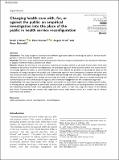Files in this item
Changing health care with, for, or against the public : an empirical investigation into the place of the public in health service reconfiguration
Item metadata
| dc.contributor.author | Greer, Scott L. | |
| dc.contributor.author | Stewart, Ellen | |
| dc.contributor.author | Ercia, Angelo | |
| dc.contributor.author | Donnelly, Peter | |
| dc.date.accessioned | 2021-11-30T16:30:02Z | |
| dc.date.available | 2021-11-30T16:30:02Z | |
| dc.date.issued | 2021-01-01 | |
| dc.identifier | 276445941 | |
| dc.identifier | e8c238cd-d2d7-4a63-910c-34415893cedd | |
| dc.identifier | 85088269600 | |
| dc.identifier | 32686515 | |
| dc.identifier | 000550732700001 | |
| dc.identifier.citation | Greer , S L , Stewart , E , Ercia , A & Donnelly , P 2021 , ' Changing health care with, for, or against the public : an empirical investigation into the place of the public in health service reconfiguration ' , Journal of Health Services Research and Policy , vol. 26 , no. 1 , pp. 12-19 . https://doi.org/10.1177/1355819620935148 | en |
| dc.identifier.issn | 1355-8196 | |
| dc.identifier.uri | https://hdl.handle.net/10023/24442 | |
| dc.description | Funding: The author(s) disclosed receipt of the following financial support for the research, authorship, and/or publication of this article: This research was funded by the Health Foundation. | en |
| dc.description.abstract | Objectives: This study sought to understand the different approaches taken to involving the public in service reconfiguration in the four United Kingdom health systems. Methods: This was a multi-method study involving policy document analysis and qualitative semi-structured interviews in England, Northern Ireland, Scotland and Wales. Results: Despite the diversity of local situations, interview participants tended to use three frames within which they understood the politics of service reconfigurations: an adversarial approach which assumed conflict over scarce resources (change against the public); a communications approach which defined the problem as educating the public on the desirability of change (change for the public); and a collaborative approach which attempted to integrate the public early into discussions about the shape and nature of desirable services (change with the public). These three framings involved different levels of managerial time, energy, and resources and called on different skill sets, most notably marketing and communications for the communications approach and community engagement for the collaborative approach. Conclusions: We argue that these framings of public involvement co-exist within organisations. Health system leaders, in framing service reconfiguration as adversarial, communicative or collaborative, are deciding between conceptions of the relationship between health care organisations and their publics in ways that shape the nature of the debates that follow. Understanding the reasons why organisations adopt these frames would be a fruitful way to advance both theory and practice. | |
| dc.format.extent | 8 | |
| dc.format.extent | 350592 | |
| dc.language.iso | eng | |
| dc.relation.ispartof | Journal of Health Services Research and Policy | en |
| dc.subject | Public participation | en |
| dc.subject | Service reconfiguration | en |
| dc.subject | United Kingdom | en |
| dc.subject | RA0421 Public health. Hygiene. Preventive Medicine | en |
| dc.subject | Health Policy | en |
| dc.subject | Public Health, Environmental and Occupational Health | en |
| dc.subject | E-NDAS | en |
| dc.subject | SDG 3 - Good Health and Well-being | en |
| dc.subject | MCC | en |
| dc.subject.lcc | RA0421 | en |
| dc.title | Changing health care with, for, or against the public : an empirical investigation into the place of the public in health service reconfiguration | en |
| dc.type | Journal article | en |
| dc.contributor.institution | University of St Andrews. School of Medicine | en |
| dc.contributor.institution | University of St Andrews. Sir James Mackenzie Institute for Early Diagnosis | en |
| dc.contributor.institution | University of St Andrews. Population and Behavioural Science Division | en |
| dc.identifier.doi | 10.1177/1355819620935148 | |
| dc.description.status | Peer reviewed | en |
This item appears in the following Collection(s)
Items in the St Andrews Research Repository are protected by copyright, with all rights reserved, unless otherwise indicated.

